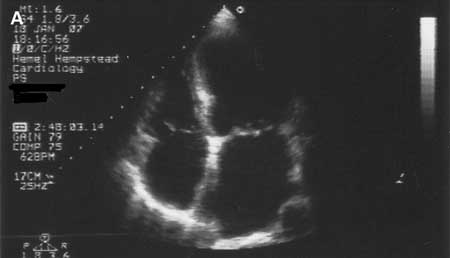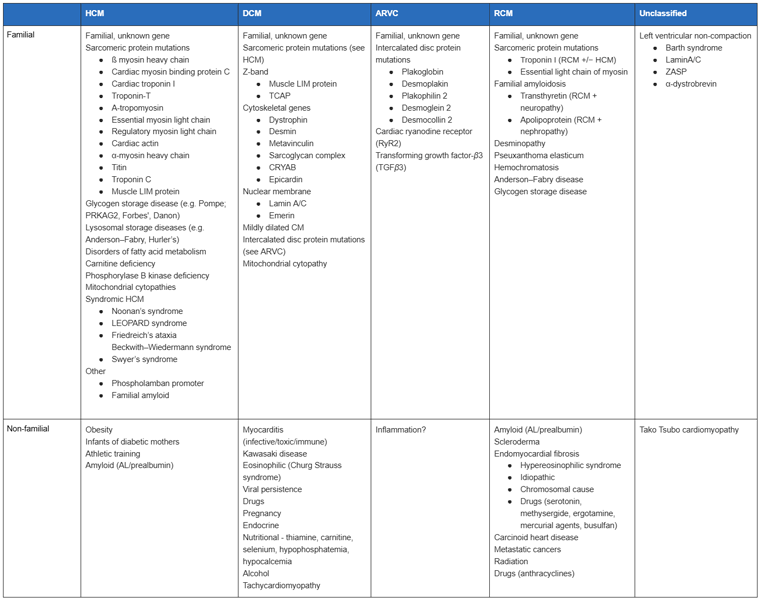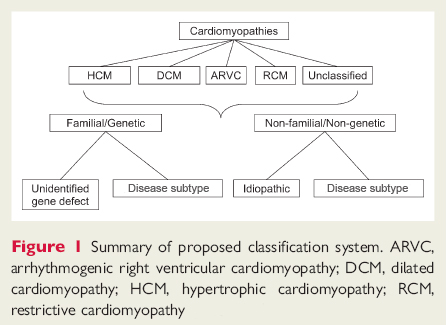შეჯამება
Diagnósticos diferenciais
comuns
- Idiopathic dilated cardiomyopathy
- Myocarditis
- Alcohol: dilated cardiomyopathy
Incomuns
- Hypertrophic cardiomyopathy (HCM)
- Idiopathic restrictive cardiomyopathy
- Arrhythmogenic right ventricular cardiomyopathy (ARVC)
- Brugada syndrome and other ion channelopathies
- Conduction system disease
- Mitochondrial disorders
- Takotsubo syndrome
- Peripartum: dilated cardiomyopathy
- Tachycardia-induced: dilated cardiomyopathy
- Amyloidosis: hypertrophic or restrictive cardiomyopathy
- Hemochromatosis: restrictive or dilated cardiomyopathy
- Fabry disease: hypertrophic or restrictive cardiomyopathy
- Other lysosomal storage disease
- Doxorubicin: dilated cardiomyopathy
- Heavy metals/chemicals: dilated cardiomyopathy
- Diabetes mellitus
- Thyroid dysfunction: dilated cardiomyopathy
- Acromegaly: hypertrophic or dilated cardiomyopathy
- Noonan syndrome: hypertrophic cardiomyopathy
- Lentiginosis: hypertrophic cardiomyopathy
- Thiamine deficiency (wet beriberi): dilated cardiomyopathy
- Friedreich ataxia/muscular dystrophy: hypertrophic and dilated cardiomyopathy
- Deficiency of iron, niacin, selenium, or vitamin D: dilated cardiomyopathy
- Systemic lupus erythematosus: dilated cardiomyopathy
- Endomyocardial fibrosis/Loeffler endocarditis (hypereosinophilic syndrome)
- Sarcoidosis
- Electrolyte disorders
Colaboradores
Autores
Katie Linden, BMSc, MBChB
Cardiology Specialty Registrar
Belfast Health and Social Care Trust
Belfast
Northern Ireland
Declarações
KL was reimbursed by Takeda UK Ltd., the manufacturer of Replagal for Fabry disease, for travel and accommodation for a leadership course. KL was reimbursed by Sanofi Aventis, the manufacturer of Genzyme for Fabry disease, for travel and accommodation for a conference. KL received a speaker fee from Sanofi Aventis, the manufacturer of Genzyme, for a talk on Fabry disease. There was no contractual right by Sanofi to control the content of this talk.
Alison Muir, MD
Consultant Cardiologist
Royal Victoria Hospital
Belfast Health and Social Care Trust
Belfast
UK
Declarações
AM is an author of a reference cited in this topic.
Agradecimentos
KL and AM would like to gratefully acknowledge Dr Pascal McKeown, a previous contributor to this topic. PM is an author of a reference cited in this topic.
Revisores
Lubna Choudhury, MB BCh, MD, MRCPI, FACC
Professor of Medicine
Division of Cardiology
Northwestern University
Chicago
IL
Declarações
LC declares that she has no competing interests.
John Coltart, MD, FRCP, FACC, FESC, MRCS
Consultant Cardiologist
Cardio-thoracic Unit
Guy's and St Thomas' Hospital
London
UK
Declarações
JC declares that he has no competing interests.
Vaikom S. Mahadevan, MBBS, MRCP
Consultant Cardiologist
Manchester Royal Infirmary
Manchester
UK
Declarações
VSM declares that he has no competing interests.
Créditos aos pareceristas
Os tópicos do BMJ Best Practice são constantemente atualizados, seguindo os desenvolvimentos das evidências e das diretrizes. Os pareceristas aqui listados revisaram o conteúdo pelo menos uma vez durante a história do tópico.
Declarações
As afiliações e declarações dos pareceristas referem--se ao momento da revisão.
Referências
Principais artigos
Arbelo E, Protonotarios A, Gimeno JR, et al. 2023 ESC guidelines for the management of cardiomyopathies. Eur Heart J. 2023 Oct 1;44(37):3503-626.Texto completo Resumo
Ommen SR, Ho CY, Asif IM, et al. 2024 AHA/ACC/AMSSM/HRS/PACES/SCMR guideline for the management of hypertrophic cardiomyopathy: a report of the American Heart Association/American College of Cardiology joint committee on clinical practice guidelines. Circulation. 2024 Jun 4;149(23):e1239-311.Texto completo Resumo
Nagueh SF, Phelan D, Abraham T, et al. Recommendations for multimodality cardiovascular imaging of patients with hypertrophic cardiomyopathy: an update from the American Society of Echocardiography, in collaboration with the American Society of Nuclear Cardiology, the Society for Cardiovascular Magnetic Resonance, and the Society of Cardiovascular Computed Tomography. J Am Soc Echocardiogr. 2022 Jun;35(6):533-69.Texto completo Resumo
American College of Radiology. ACR appropriateness criteria: nonischemic myocardial disease with clinical manifestations. 2020 [internet publication].Texto completo
British Society of Echocardiography. Diagnosis and assessment of dilated cardiomyopathy: a guideline protocol from the British Society of Echocardiography. Jun 2017 [internet publication].Texto completo
Artigos de referência
Uma lista completa das fontes referenciadas neste tópico está disponível para os usuários com acesso total ao BMJ Best Practice.

Folhetos informativos para os pacientes
Heart failure
Heart failure: how can I help myself?
Mais Folhetos informativos para os pacientesVideos
Third heart sound gallop
Fourth heart sound gallop
Mais vídeosConectar-se ou assinar para acessar todo o BMJ Best Practice
O uso deste conteúdo está sujeito ao nosso aviso legal

